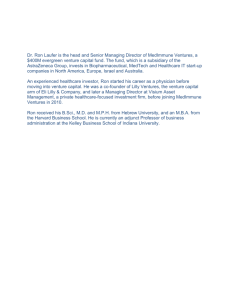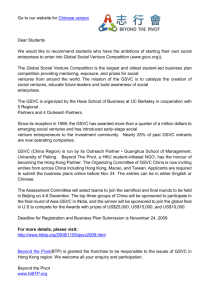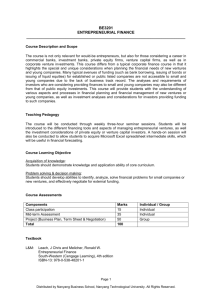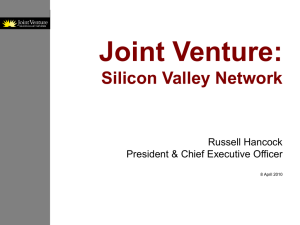A Framework and Tools for Entre- and Intra
advertisement
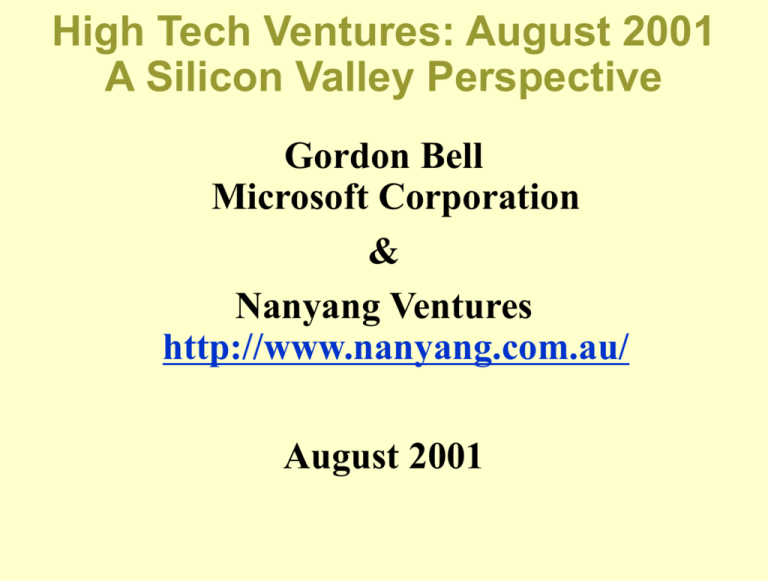
High Tech Ventures: August 2001 A Silicon Valley Perspective Gordon Bell Microsoft Corporation & Nanyang Ventures http://www.nanyang.com.au/ August 2001 Summary • We’ve witnessed the greatest, all time, wealth creation and destruction period. Ponzi? Conspiracy? • .com era allowed any idea to get extraordinary funding, valuations, and payoff. Little technology! • Silicon Valley has capital. But, VCs busy with old projects. • Real technology exists and is increasing! But, I don’t see a chance to “spin a yarn” like www! • What counts AGAIN, are fundamentals: Team, product, marketing … and execution! • Lots can go wrong! Internet Bubble Lessons • Laws of economics still apply • Risk/reward at a new level • Technology enablement available to all • Infrastructure is means, not end • Internet connectivity doesn’t mean integration • Big changes take >5+ years. In the long run, it will all be true! • Cash is still king! • Company failings is still growing. Peak by year end. “Now this is not the end It is not even the beginning of the end But it is, perhaps, the end of the beginning” Winston Churchill, 1942 TECHNOLOGY DEVELOPMENT BIO INTELLIGENCE AGE CONSUMER ACCEPTANCE 2000 BC 0 1500 1800 1900 2000 AD TIME (year) R. Satava 29 July 99 Outline • Situation in Silicon Valley / Bay Area 2001 August – Unlike our PR, streets aren’t paved with gold – You have to dig for it versus pick it up – Now it is much harder than 2 years ago – Good business for pick and shovel makers! • Bell-Mason Model for a startup and the diagnosis of them … the fundamentals haven’t changed • Look at the environment that supports it and compare it with the area in Boston. • Lessons for .au? • Red flags and flaws … what to look our for Slowdown in the valley: What's ahead Mercury News 5 August 2001 Economic recovery may lag The Internet bubble burst, as painful as it's been, follows a historical pattern. Although a slow recovery is predicted, experts say technology is still the key to future growth. BY DAVID A. SYLVESTER Silicon Valley, get ready for life in the slow lane. After five years of turbocharged growth, the tech-dominated economy here is still plunging toward a bottom. WSJ 7/27… technological gloom • Mary Meeker … famous for the rise of the Internet …, estimated that $727 billion has been lost by the … 360+ Internet companies 12/99-07/01. Ms. Meeker adapted an aphorism from the Great Depression … The "biggest risk we face, is not being willing to continue to take risks." • … many venture capitalists are so busy shutting down their existing companies, or trying to arrange bailouts, that they have little time or appetite for new deals. • Stewart Alsop, a general partner at NEA, … made 10 or 12 investments this year, compared to 50 in the same period of 2000. Instead of griping about excessive valuations demanded by start-ups, he is now steeped in the onerous contract terms that firms impose during "down rounds“. Shutdowns & M&A 2000-present VC Finding(t) Some statistics and sayings • Technology industry: $7.6B invested 2001Q2, vs $24.8B 2000Q2. • 555 Internet start-ups have closed since the beginning of 2000, >75% in the past eight months • In the first half of 2001, 330 .coms shut down – Consumer companies accounted for 26% of shutdowns, vs 43% last year, – Business-to-business accounted for 33% of shutdowns, vs 22% last year. – Electronic commerce start-ups comprised 40% of closings, vs 54% in 2000; – ASP shutdowns rose to 10% from 8%. • In June, 53 .coms ceased business, vs. May record of 60 • ``the biggest Ponzi scheme in the postwar era,'' says K. Rosen, UC-Berkeley. ``And we were in the center of it, right in Silicon Valley.'' California, Here I Go b2c & b2b- back to Cleveland & Boston "New technologies always SOUND HOT…the problem is knowing what’s NOT." -gbell • .coms NOT. • Moore’s Law drives startups. 10X transistors/die /5 yrs. – Microprocessor-based: Java, games, DSP, multiprocessors – Communications: DSL, switch traffic 4x/year – MEMs, leading to Nanotech • Communications: 4x/year traffic growth. They are all in debt! • Wireless NOT. Carrier & platform limited. Crowded. • Games. Industry is > movie • Drug discovery given the genomic map. Bio-x. • Opportunities: – convergence of computer with phone & with TV – Energy conservation "The technological possibilities are endless ...all we have to do is sort through them." The Bell-Mason Diagnostic A system for ... • Measuring risk • Predicting course • Tracking progress • Improving the odds of success ... of high tech, high growth, early stage ventures The Bell-Mason Diagnostic Founding Premise “You don’t have to understand the technology to ask the right business questions.” The Bell-Mason Diagnostic provides the critical technology, product, marketing, and people expertise. The Bell-Mason Diagnostic • Space Twelve standard dimensions characterize a venture (a chapter of High-Tech Ventures). • Time Four, well-defined stages of company development with 7 sub-stages of product and market development. • Quantification Clear, yes/no questions (i.e. rules) encapsulate knowledge for evaluating a company. • Visualization A relational graph shows company position. 12 Dimensions of Analysis MARKET PRODUCT Business Plan Manufacturing Marketing Service/Delivery Product Sales Technology/ Engineering CEO Team Control FINANCE/ Financeable CONTROL Cash Board of Directors PEOPLE Four Stages of Growth Concept Stage 1 day to 12 months Stage 3 Stage 2 Stage 1 $ $ Seed Stage 3 to 12 months Product Development Stage Stage 4 $ 12 to 48 months Market Development Stage 24 to 48 months Concept Seed Product Market Ventures Context for Digital Strategy Ventures Stage 1 Angel $ Idea Stage 2+3 Seed Stage $ Stage 4 IPO $ Concept Stage 1 day to 9 months Product Development Stage Market Development Stage 9 to 12 months 11 to 30 months Bell-Mason Diagnostic Staged Evolution of Questions… from roughly 1,000 for all stages! • Concept “Does the company have evidence of product possibilities, given the technology, that customers are likely to buy?” • Seed “Does a simple product specification exist with features and functions that can be presented to potential users?” • Product Development “Are an appropriate number of beta systems (3 for large systems, >20 for mass marketed software) operating in real user environments with users satisfied and testifying that the product exhibits unique capabilities and/or significant performance and/or performance/price benefits?” Evolution of the “Ideal State” at Each Stage: Entrepreneurials Stage IV. Market Development Business Plan Manufacturing Marketing Product Development Stage III. Product Development Sales Stage II. Seed Stage I. Concept Technology/ Engineering CEO Team Control Fundability Board of Directors Cash Bottom line • The startup process can be codified and measured according to a model • Deviating from “best practices” is a risk to company and investors • There’s rarely a shortcut for starting a successful venture © The Bell Mason Group 21 Context for New Ventures • How do you support them? • Look at Silicon Valley versus Boston’s Rte 128 • Needs of area to support venture © The Bell Mason Group 22 Sonicbox Garage Sonicbox: Establishing Internet Radio Si Valley vs Route 128 (Hi Tech Employment 000’s) Saxenian 1994 300 250 200 Si Valley Rte 128 150 100 50 0 1959 1970 1980 1990 Rte 128 and Si Valley VCs behave as bankers Finance focused Established industries Military contract companies Vertical integration (DEC) MIT… few rich profs. (Close to Washington DC) Protection of IP Silicon failed (large co’s) Hi-tech is just another biz Gen. Purpose infrast. Risk is to be avoided Work to live VCs behave as investor/partner Content, contacts & assistance Growth from new companies Large, and many startups Horiz. Integration & compon. Key ideas: IC, Micro, disk! Stanford, UC/Berkeley (Close to industries) Free flow of people & ideas Silicon from the beginning Hi-tech is the only biz Hi-tech focus Risk is admired & rewarded Live to work & pay for lifestyle Exogenous Effectors for Each Dimension Tech workforce, sub-contractors, components Reasonable expectations, patience, Competitive Products, co-components Market, infrastructure for "complete" product, partners, strategic alliances, PR, etc. Customers, sales personnel, channels to international mkt. Eng, sci., tech, tech svcs, uni’s, other companies, consultants Trained pool of gen. mgrs successful "role models" Trained personnel to hire, area-specific consultants Acctng, legal, financial/financing infra- structure Capital market supply Cash & financing experience, "patience" BOD with Industry, market, product, engineering, financial experience An “ideal” Venture Capitalist • Has a reasonable sized fund, but not too large… • Has access to friends who have plenty of funds including bankers and M&A folks • Has “done it” before as an operational professional • Knows your industry. – Customers and suppliers – Consultants, potential employees • Knows infrastructure: acc’tng, legal, recruit, PR • Great company salesperson & recruiter • “You’re happy to be with them in a law suit.” -Doerr • Past success: knows difference between luck & skill • Smarter than you are… and willing to teach you Personal Failures… when I didn’t luck out Failure to use the BMD! NO due diligence…use 2 sec. Gut! •Buying a dream or idea, NOT team|plan. • A lone ranger’s algorithm, isn’t a product or company • Features, UI’s just aren’t products, let alone company! •No viable biz plan… just an idea that one could exist. •Gut > logic… just like the idea or team. •CEO problems or Sociopath on the team? •Team turns on each other. Won’t|can’t hire CEO or x. •Friends: “helping” in some capacity! •Flattery|need: we need you on the BOD! •Do it for money… w/o due diligence. •Poor “money manager” post IPO Chameleon: PC/XP & CE phone I. Concept Stage Activities • • • • • • • • "Inspiration and Speculation" Average Duration: 0 - 6 months Principal Activities and Achievements: Formulation of idea for technology/product innovation. Initial field investigation to "test" application vision. Acknowledgement by 3 reputable outside sources of a product and business. First business plan (6-10 pages). First funding to go to Seed and make a proper plan. I. Concept Stage Flaws and Flags • • • • • • • • • • No clear articulation of vision or competition Faulty or non-existent business plan The vision constitutes research or hope Not a company, but a: feature, algorithm, one product event Over-reliance on new components or new suppliers or new infrastructure Lack of credible sources who support the technology/product premise No acknowledgement of competition NO team or the wrong team... (e.g. too many new tricks for old dogs?) No risk assessment Over financing without going to Seed (planning) Stage II. Seed Stage Activities • • • • • • "Exploration and Resolution" Average Duration: 3 - 12 months Exploration key technologies to prove feasibility Product Specification and Products Requirements First product devel. schedule made with team Exploration and refinement of key market assumptions and positions, models, applications, and channels • Preliminary Customer/Application Profiles built • Full, formal business plan • Funding for Product Development II. Seed Stage Flags and Flaws • Insufficient technology feasibility (product may be research); or it may not be unique or differentiated; or it may be one shot • No clear product specification (and no predictability on scheduling and real resources required) • No "design for manufacturability“ or “delivery/support”? • Engineering and Marketing both have a great product vision -- but they're contradictory • No Product Requirements Document or Lack of Market Vision • Untested market assumptions and models • No written Customer/Application Profiles and loose definition of market segments II. Seed Stage Flags and Flaws-2 • Insufficient model of the lead-time to sale by segment and channel • Miss-perceptions re: competition and advantage • Flawed team: lack of credentials and no clear solution to attract the right talent and fill voids • "Penny-wise, pound-foolish"-- delaying expenditures for critical resources • Business plan is a fund-raising document, not a dynamic control document -- i.e. the top line is unrealistic; sales forecast is just a 'hockey stick' • The Board is just founders and VCs • Company misses Seed milestones III. Product Development "Construction" • Average Duration: 12 to 48 months (avg. 24) • Principal Activities and Achievements: • Engineering team is hired and product is built, according to specification. Development goes through four phases: – a)hire the team, specify the product in detail and plan the project and all support processes – b)test the specification and simulate its operation, building operational prototypes – c) integrate and alpha test under operational conditions – d) beta test in the field at customer sites. III. Product Development-2 "Construction" • Engineering and Marketing iteratively refine FFB's and product positioning according to Customer/Applications Profiles and requirements. • By end Beta, delivery organization and process, including manufacturing is completely formed. • Marketing works iteratively, closely with Engineering throughout this stage. • Marketing's programs are in place at end Alpha and beginning to be implemented in Beta. (Note: Beta is the last opportunity to test under a shield of privacy and confidentiality.) • Additional funds are often raised to finance market entry and calibration, based on Beta progress. • III ends with product introduction. III. Product Development Red Flags and Fatal Flaws • Technology-to-product translation simply didn't work as planned (too low, too high, too elegant) • Company needs new tools to develop the product -- couldn't invent or obtain given current plan. • Company reliant on other vendors for product performance. • No product architect. • Schedules/milestones are constantly missed; funds used faster than forecast. • Product isn't Beta Tested. • Systems integration problems. • Manufacturing can't produce product for target cost. III. Product Development Red Flags and Fatal Flaws-2 • Business Plan isn't updated, and reflects unrealistic break-even point. • Key customers aren't identified per segment. • Pricing and availability are still in flux. • Strategic partner candidates not interested. • Product is introduced before it exists. • Sales is on too early; marketing is on too late. • Marketing is vision-less and has no written plan. • Marketing has no Market Segment Development Schedule. • Sales and/or channel strategy is mismatched to product. • Team is at war, and there's no consensus. IVa. Calibrate the Market “Commercialization" • Average Duration: 3 to 9 months (avg. 6 months) • Principal Activities and Achievements: • Every line of business plan is now operable and tuned for determining profitability. • Every department's operations and plans are tested. • Engineering responds to field problems and joins in team sales. • Modifications to product, enhancements, next releases, new products are handled by Phase Review product planning process. IVa. Calibrate the Market-2 “Commercialization" • Manufacturing is fully staffed and delivering product on schedule at the correct cost, quality and volume commitments. • Marketing and Sales drive the company. • Marketing validates/recalibrates its Market Segment Development Schedule, positioning, unique selling propositions per segment, sales gestation times. • Sales hones its prospecting and pre-qualification filters, and tunes its forecasts. • Making sales is the top priority of the company (meeting 3 and 6 month forecasts). • Financing for IVb Market Expansion is often undertaken. IVa. Calibrate the Market Red Flags and Fatal Flaws • Engineering ships a buggy product and spends all its time fixing the product in the field. • Weekly meetings to cover product status and categorize/prioritize change requests don't happen (changes are ad hoc and priorities are not established). • Departments aren't following their own plans as central control and measurement documents. • The Phase Review (or some other similar process) isn't instituted as a means to organize cross-company communication and decision making re: the product and follow-on's. • Engineering is understaffed to handle field maintenance and new development. IVa. Calibrate the Market Red Flags and Fatal Flaws-2 • Engineering ships a buggy product and spends all its time fixing the product in the field. • Weekly meetings to cover product status and categorize/prioritize change requests don't happen (changes are ad hoc and priorities are not established). • Departments aren't following their own plans as central control and measurement documents. • The Phase Review (or some other similar process) isn't instituted as a means to organize cross-company communication and decision making re: the product and follow-on's. • Engineering is understaffed to handle field maintenance and new development. IVa. Calibrate the Market Red Flags and Fatal Flaws-3 • The product is introduced far before it can be shipped ("vapor"). • Manufacturing can't product the product at appropriate unit cost, according to committed schedules, and the quality levels aren't met (DOAS, bad installation procedures, lack of service, no spares, etc.) • Marketing's assumptions, positioning and unique selling propositions are off (beyond fine-tuning). • Marketing's specifications/programs for customer service and support are insufficient to maintain "satisfaction" level (e.g., can't respond to problems within 24 hours, inadequate documentation, insufficient level of initial and ongoing training, many complaints). • Marketing doesn't have a completed Market Segment Development Schedule and a completed market plan to drive Its own operation and strategically direct Sales. IVa. Calibrate the Market Red Flags and Fatal Flaws-4 • Marketing and/or Sales' forecasts of lead time to sale per segment are off. • Marketing has a completed Market Segment Developmenth Group 1 early adopters, but can't transition to Group 2 segments to expand the market position and sales volumed Engineering stalemate on action required by changes to FFB's; political infighting and finger-pointing starts eating up time and energy. • Marketing and Sales have presold functionality that now can't be attained in real product operation in the field (in specific applications, or "across the board"). IVa. Calibrate the Market Red Flags and Fatal Flaws-5 • Marketing is short on strategy and long on tactics. • Marketing Is understaffed, or inappropriately staffed. • Marketing doesn't strategically drive Sales with segment targets, key reference customers, training and support necessary to make sales (e.g., Sales is on its own). • Sales doesn't agree with Marketing's Market Segment Development Schedule, market plan, or with specific identification and prioritization of sales targets. • Sales is completely opportunity and personality-driven that makes forecasting unpredictable, at best. • Sales has hired the wrong type of sales people for the product/company. IVa. Calibrate the Market Red Flags and Fatal Flaws-6 • The company's third-party distribution agreements, now operable, are in conflict (e.g., the company has an agreement with a retail chain and begins mail order sales in the same areas.) • Marketing has underestimated the level and cost of support for third-parties (e.g., VARs end up requiring more training and assistance; company must team-sell to close VAR sales; volume doesn't Justify support costs; VAR getting deeper discount, but is operating like, a non-value added distributor. • Marketing hasn't created enough interest in the product in the end-user markets (through marketing communications and key sales) to motivate aggressiveness from OEMs and other third parties. IVa. Calibrate the Market Red Flags and Fatal Flaws-7 • The product's current feature set is insufficient to support third-party requirements. • Sales forecasts for the first 3 and 6 months weren’t met. • Sales forecasts for the first 3 and 6 months were met, but do not support the business plan's model of operation for the next 12-18 months (IVb), pushing out break-even. • Funds were raised based on a plan that is no longer feasible. • The company is unable to raise more funds, or can do so only by diluting current stock value, because of disappointing performanceIVa. IVa. Calibrate the Market Red Flags and Fatal Flaws-8 • The CEO isn't current on the issues across the departments and through exec staff MBOs. • The CEO makes far-reaching decisions too quickly or too slowly. • The CEO isn't making weekly or bi-weekly customer visits and key sales calls. • The CEO is an Ineffective spokesperson for the company and product. • The CEO is totally immersed in Sales and neglecting ongoing strategic business planning for the company. IVa. Calibrate the Market Red Flags and Fatal Flaws-9 • The Board of Directors is involved in day-to-day operations and decision making (i.e., the CEO isn't in control). • Cash flow is unpredictable (e.g., accounts out greater than 60 days). • The company's expenses are higher than forecast. • The company isn’t managing to the “bottom line”, but is hoping for a miracle. End Bit Engineering & Marketing Stages Synchronization Engineering Concept Stage I Seed Stage II Aug. 95 Product Development Stage III a | b | c |d Market Development Stage IV a | b | c Marketing Concept Stage I Jan 96 Seed Stage II June 96 Product Development Stage III a | b | c |d Market Development Stage IV a | b | c The Bell–Mason Group, Inc. Systems for Venture Development, ©1996 New Venture Models Stages of New Venture Growth Concept Seed Product Dvpt. Independent Start-Up Venture Capital Funding Self funded Market Dvpt. Estab’d. Business Corporate Ventures Spinout Business Unit Internal Marketing Joint Venture Engineering Strategic Alliance Acquisition Entrepreneurial vs. Intrapreneurial Ventures Venture goals Funder’s measures of success Competition Resources Structure Entre Independent Profits, ROE, IPO/Aquisition External Scarce Simple, stand alone Staffing CEO+ small team Intra Set by parent Revenues, strategic business position, market share Internal & external Plentiful Complex, ties to corporation Larger teams, matrix organizations Entrepreneurial vs. Intrapreneurial Category • Tech./Eng. • • • • Product Mfg. Plan: Marketing Entre no process, few people Intra many processes, questionable goal more related to a market likely to be "Field of Dreams" often out-sourced forced to be internal crisp,but often unreal variable (0 to very detailed) weak, hard to do ......... unrealistic, hard deal-making venture $s drives a plan no early market planning incompetence is size & organization independent • Sales built as needed co-mingles with corp, • CEO/GM founder or vc choice often missing, hard to find • Team focused on venture diffused throughout organiz. • Board important mgmt. comp. missing • $s too few, easy to hire/fire blank check... few people ²s • Financeable a concern, easy to stop blank check, hard to stop • Control lax over-control, long time const. Summary Observations: Imperatives for Success • Corporate body guiding new ventures must understand new venture development model • Corporation must inventory and leverage core competencies (otherwise, true roulette) • Start-up’s don’t naturally live in established, large corporations: must be structure that provides early insulation and (much) later assimilation • Entrepreneurs don’t exist naturally in established, large corporations: personnel must be continually trained and selfselected— and imported • New ventures must acquire understanding of missionary marketing/sales techniques and build new positions/job descriptions that reflect it
